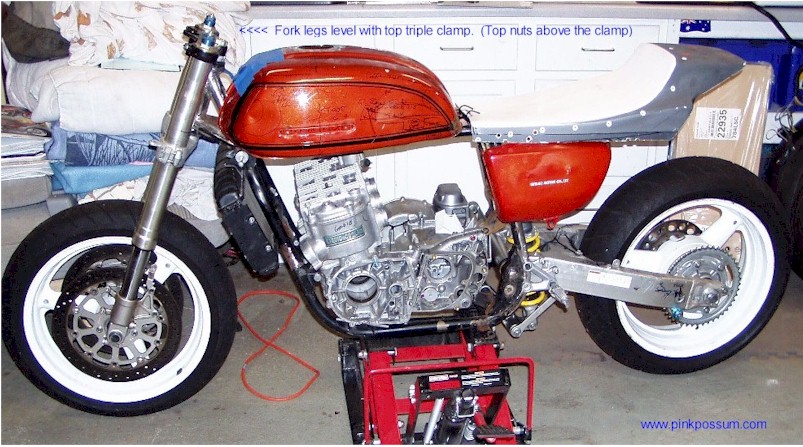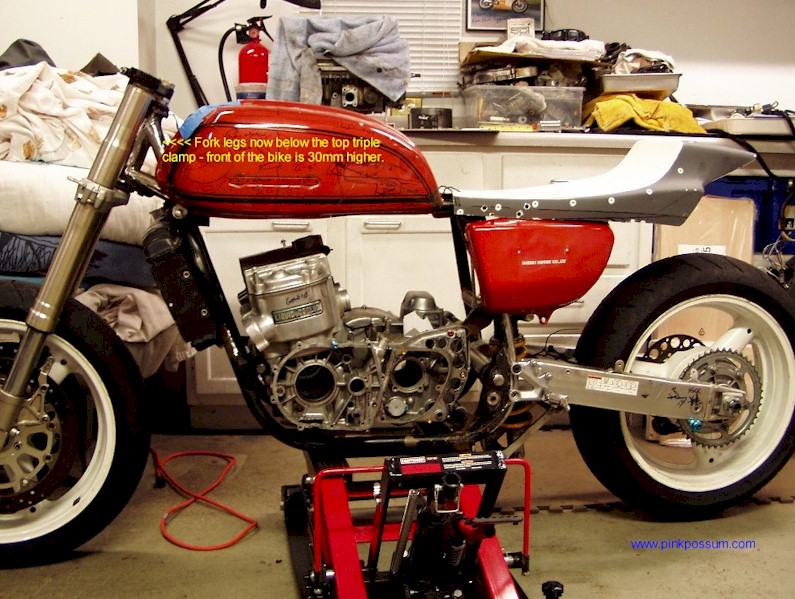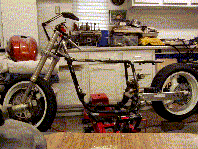
In this picture, the forks are level with the top of the upper triple clamp and the swingarm has about 10 degrees of droop. |
Phat Trakka
Part 4a: The angle of the dangle.
Time to put the major parts together and work out exactly what needs to be done to achieve the design intent. The swingarm was assembled with the modified spindle and the forks and wheels were slipped into place and bolted up. A set of empty motor cases were slipped into the frame to test for suitability.

In this picture, the forks are level with the top of the upper triple clamp and the swingarm has about 10 degrees of droop. |
The lift is directly under the pair of center stand brackets which are almost straight below the swingarm pivot. the lift was lowered until the swingarm had zero droop ( ie flat horizontal) and was raised up to measure the changes to swingarm droop, fork rake and seat height.
As the lift was raised, the both wheels stayed on the ground. The center of the bike rose and so did the seat height. Likewise, the swingarm droop increased. Slightly less obviously, the forks became steeper as the bike rose.
The forks were initially set so that the top nuts were just above the top triple clamp. It should also be noted that only one of the two stem nuts was in place so the top triple was 6mm lower than it "should" have been.
The bike was jacked up and readings taken at 2 degree intervals and entered into an Excel spreadsheet. Then the fork tubes were slipped lower down 15mm through the triple clamps and the whole process repeated. Then teh fork tubes were dropped a further 15mm and the process repeated. The 30mm maximum drop is what could be achieved using a CBR 954 top triple clamp and a pair of Race Tech fork extenders.
 |
|
In this picture the forks were dropped through the triples to raise the front end of the bike. The swingarm was at about 6 degrees of droop. If the project requires the front end of the bike to be any higher, it would need custom triple clamps and/or Fork top nut extenders like these from Traxxion Dynamics.
The data plotted was Rake angle (measured at the steering stem) versus Droop angle of the swingarm, for each of the three fork settings. Series 1 is just above the triple clamp, Series 2 is 15mm lower and Series 3 is 30mm lower.

As can be seen from the chart above, as swingarm droop increases, rake angle decreases. The design intent was 24-25 degrees of rake with around 10 degrees of droop. looking at the chart, it's clear that 24 degrees of rake is possible at 6 degrees of droop with the top nuts just above the triple clamp, or with just over 8 degrees of droop if the forks are dropped by 15mm and with 10 degrees of droop if the forks are dropped by the full 30mm.
Pass the step stool please..
That raised the question of how tall would the bike be at that points and what effect did raising the front end have on seat height.
A second chart was drawn for the same Droop angles versus Seat Height. To make things easier and more repeatable, the seat was removed and the actual measurement was to the top of the seat tube at a particular point.

The chart illustrates the fact that raising the front end of the bike by dropping the froks through teh triples had negligible effect on seat height on the mock up. On a real bike, raising teh front end would raise the whole bike and would also creat more droop. In the mock up, the shock is not connected, so the frame basically pivots around the swingarm bolt allowing us to measure the effect of one variable at a time.
It is also easy to see that with a flat (zero droop) swingarm, the seat height is a nice low 27 inches, rising to 34 inches at 16 degrees. At the target of 10 degrees, the seat height is already almost 32 inches and there's no seat there yet. With a seat base and say 1 inch of foam, the seat would be over 33 inches tall - too tall for my short legs.
The animation is a series of photos take at 2 degree intervals from zero to 16 degrees. Then the forks were dropped by 36mm in the triple clamps - you can see the forks twitch. See how much the seat frame rises as well as the fork rake changing. This is what happens ( on a smaller scale) as ride height is changed.

Conclusions:
- 10 degrees of droop and 24 degrees of rake is possible
- To achieve that, the forks have to be dropped - which is what Richard Lindoe did on his K5 Kettle
- The seat will have to be dropped by cutting the top frame tubes off and lowering them by about 2 inches
Part 5: Bump and grind, the down and dirty.....